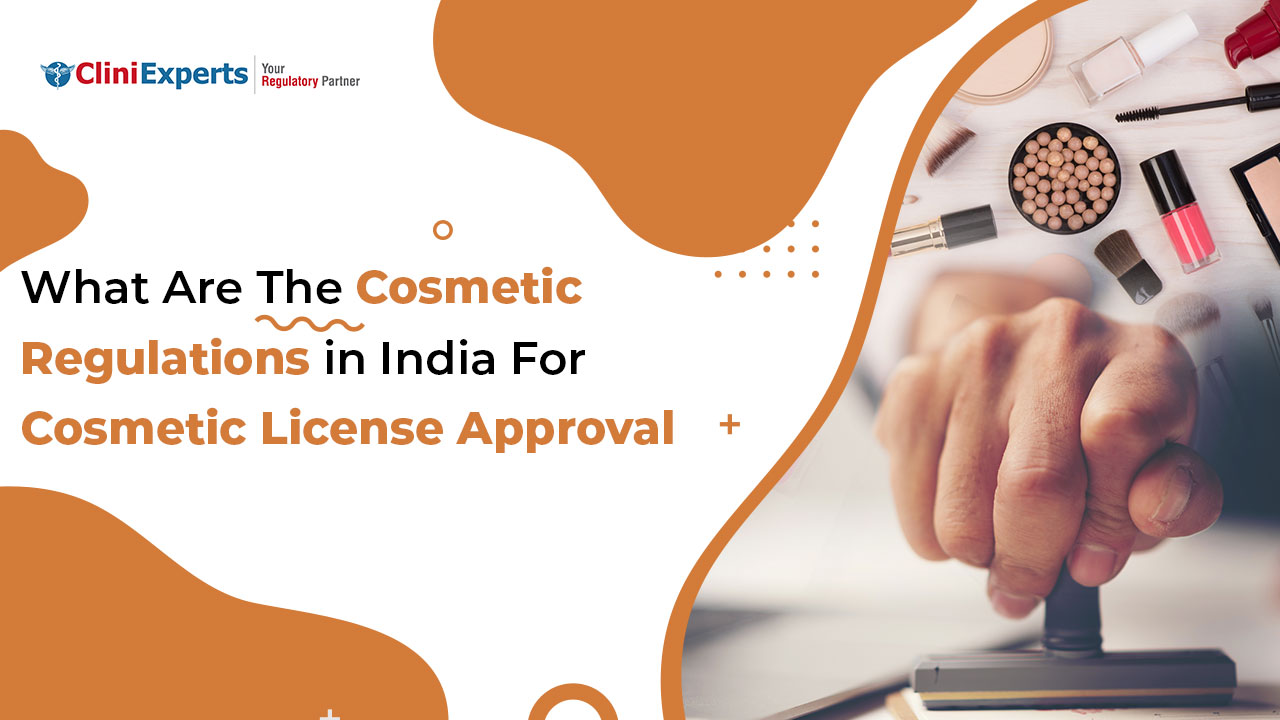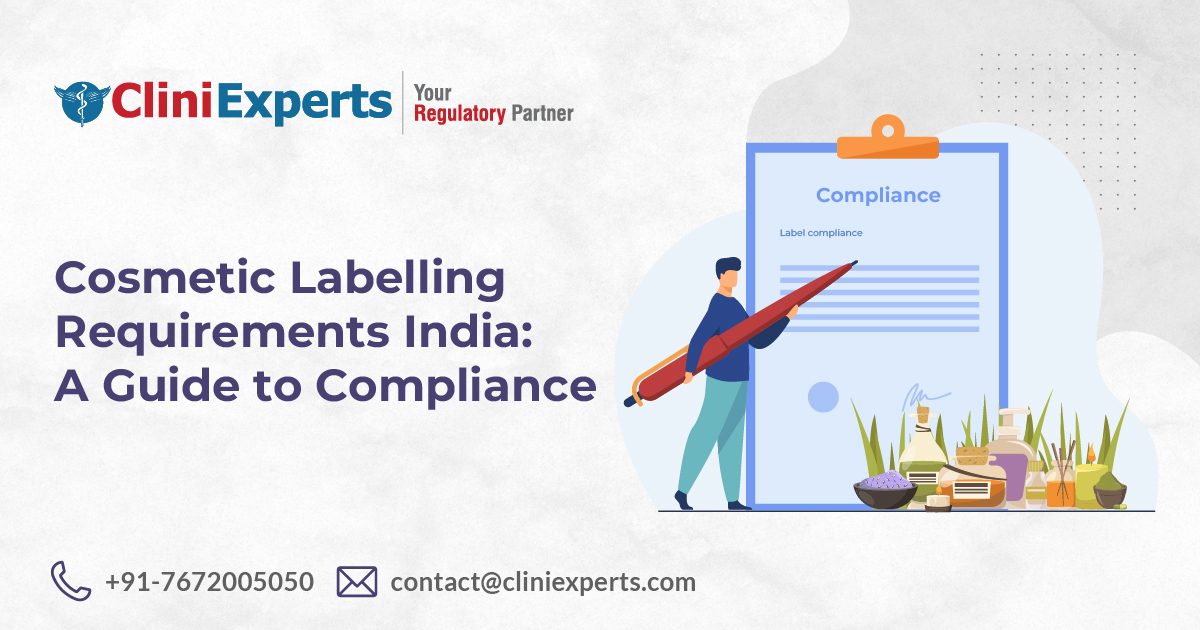Table of Contents
What Are The Cosmetic Regulations In India For Cosmetic License Approval?

According to the Drugs and Cosmetics Act, 1940, and New Cosmetics Rules 2020 and the Rules enacted thereunder, the State Drug Control Department inspects and grant cosmetic license approval for importers and manufacturers in India. Additionally, the import of cosmetics is governed by a registration system administered by the Central Drug Standard Control Organization (CDSCO), which is responsible for regulating cosmetics activities and propagating corresponding regulations.
Animal-tested cosmetics and cosmetics with heavy metals such as hexachlorophene, lead or arsenic compounds are prohibited from entering India. Other examples include cosmetics containing mercury.

Regulatory Framework and Competent Authority For Cosmetic License Approval
1. Present Major Cosmetic Regulations, India
| Cosmetic Regulations | Function of Regulation | Effective Date | Status |
| Drug and Cosmetic Act 1940 & Rules 1945 (revised up to Dec. 31st, 2016) | A comprehensive regulatory guide for manufacturers, importers, distributors, and sellers of cosmetics | 2016-12-21 | Active |
| Cosmetics Rules 2020 | Registration instructions for imports of cosmetics | 2020-12-15 | Active |
| Frequently Asked Questions Of Cosmetics | Clarify any details in the guidelines that are unclear | 2020-12-15 | Active |
| Classification of Cosmetic Raw Materials and Adjuncts Part1 & Part 2 | The list of cosmetic ingredients that are restricted and prohibited | 2017-03-01 | Active |
2. Competent Authority For Cosmetic License Approval
As a result, there are two organizational levels of Drug Control: State Governments and the Central Drugs Standard Control Organization (CDSCO). The CDSCO is the main authority responsible for regulating activities related to cosmetics and for promulgating corresponding regulations.
CDSCO has established an executive sector the Drugs Controller General (DCGI), India to handle activities such as applications for registration or license.
CDSCO’s main functions for cosmetic regulation include:
- Amending the Drugs & Cosmetic Rules, 1945 and New Cosmetics Rules 2020 and with regards to import registration for cosmetic products.
- Reading and evaluating applications for registration of cosmetics as per rules promulgated by the Drugs and Cosmetics Act 1940 and Rules 1945 and New Cosmetics Rules 2020, thereunder.
- Reviewing and evaluating various applications for NOCs/Clarifications related to the import of cosmetic products.
- Prepare drafts responses to RTI requests, VIP requests, and Parliament questions related to cosmetics.
- Responding to Government correspondences and BIS requests as required.
- Assisting the public with inquiries/hearings regarding import registration of cosmetics and providing guidance thereon.
- Deal with complaints from the general public, NGOs, consumer forums, and business associations about cosmetic standards.
- Registration of cosmetic import requests received from the applicant is pre-screened.
- The pre-screening checklist and standard operating procedures for evaluating cosmetic import and registration applications have been amended to reflect the current working procedures.
Department of State Drug Control deals with licensing of both cosmetic manufacturing and sales establishments, and one of its most important jobs is to ensure that quality drugs are supplied to the people of the state at an affordable price as regulated by GOI (NPPA).
The Bureau of Indian Standards (BIS) also provides specific specifications for cosmetics and has published lists of banned and allowed ingredients used in cosmetics.
Cosmetic Products
Definition Of Cosmetics
As per the Drugs and Cosmetics Act and Rules, cosmetics in India are described as an article designed to be massaged, poured, streaked or sprayed on, or introduced into, or otherwise applicable to, the human body or any part thereof for purifying, beautifying, promoting attractiveness, or changing the appearance, and involves any article designed to use as a component of cosmetic.
Cosmetic Classification
| Sr. No. | Category |
| 1. | Face care products other than face mask |
| 2. | Face mask |
| 3. | Eye contour products |
| 4. | Lip care products |
| 5. | Hand care products |
| 6. | Foot care products |
| 7. | Body care products |
| 8. | External intimate care products |
| 9. | Chemical exfoliation products |
| 10. | Mechanical exfoliation products |
| 11. | Skin lightening products |
| 12. | Other skincare products |
| 13. | Soap products |
| 14. | Bath/shower products |
| 15. | Make-up remover products |
| 16. | External intimate hygiene products |
| 17. | Other skin cleansing products |
| 18. | Chemical depilatories |
| 19. | Physical epilation products |
| 20. | Other body hair removal products |
| 21. | Bleach for body hair |
| 22. | Products with antiperspirant activity |
| 23. | Products without antiperspirant activity |
| 24. | Shaving products |
| 25. | Pre-/after-shaving products |
| 26. | Other shaving and pre-after-shaving products |
| 27. | Foundation |
| 28. | Concealer |
| 29. | Other face make-up products |
| 30. | Mascara |
| 31. | Eye shadow |
| 32. | Eye pencil |
| 33. | Eyeliner |
| 34. | Other eye make-up products |
| 35. | Lipstick |
| 36. | Lipstick sealer |
| 37. | Other lip make-up products |
| 38. | Body / facial paint, including “carneval make-up” |
| 39. | Other make-up products |
| 40. | Hydro alcoholic perfumes |
| 41. | Non hydro alcoholic perfumes |
| 42. | Before/after Sun products Sun protection products |
| 43. | Self-tanning products |
| 44. | Other sun and self-tanning products |
| 45. | Other skin products |
| 46. | Hair conditioner |
| 47. | Scalp and hair roots care products |
| 48. | Anti hair loss products |
| 49. | Other hair and scalp care and cleansing products |
| 50. | Antidandruff products |
| 51. | Oxidative hair color products |
| 52. | Non oxidative hair colour products |
| 53. | Hair bleaching and dye remover products |
| 54. | Other hair colouring products |
| 55. | Products for temporary hair |
| 56. | Styling permanent wave products |
| 57. | Hair relaxer/straightener products |
| 58. | Other hair styling products |
| 59. | Hair sun protection products |
| 60. | Other hair and scalp products |
| 61. | Nail varnish/ Nail make-up |
| 62. | Nail varnish remover |
| 63. | Nail varnish thinner |
| 64. | Nail bleach |
| 65. | Other nail varnish and remover products |
| 66. | Nail care products |
| 67. | Nail hardener |
| 68. | Other nail care/ nail hardener products |
| 69. | Nail glue remover |
| 70. | Cuticle remover/softener |
| 71 | Nail sculpting products |
| 72. | Other nail and cuticle products |
| 73. | Toothpaste |
| 74. | Tooth cleansing powder/salt |
| 75. | Other tooth care products |
| 76. | Mouth wash |
| 77. | Breath spray |
| 78. | Other mouth wash/breath spray products |
| 79. | Tooth whiteners |
| 80. | Other oral hygiene products |
Manufacturing License for Cosmetics / Cosmetic License Approval For Manufacturers
Cosmetics are regulated in accordance with the Drugs and Cosmetics Act, 1940, and New Cosmetics Rules 2020 and its regulations. The State Drug Control Departments are responsible for the inspections and licensing of cosmetic manufacturers.
For the sale of cosmetics in India, an application can be made on the websites of individual states. Specific procedures are different from one state to another. Manufacturing licenses for cosmetics are granted in form COS- 8 and COS-9 to manufacture / sale / distribute cosmetics. The following are the documents required by the states for granting cosmetic manufacturing licenses –
- Application forms COS-5 & COS-6
- Challan of fee deposited
- Declaration form
- Key plan (Blueprint)
- Site plan (Blueprint)
- Basis of possession of the premises
- Proof of premises, if rented
- Proof of constitution of the cosmetic firm (Certified copy)
- Affidavit of non-conviction of Proprietor / Partners / Directors under Drugs & Cosmetics Act, 1940
- Educational Qualification Certificate of Production Chemist and Analytical Chemist along with Approval Copy issued from SLA.
- Affidavit stating that the Production Chemist and Analytical Chemist is working full-time for the company, duly attested by a notary
- Appointment letter of the Production Chemist and Analytical Chemist individual, if employed by the company.
Any cosmetic products can be manufactured with the license given by the licensing authority appointed by the State Government. It is also crucial that the manufacturer ensures that a competent and qualified technical staff is on hand throughout the production process, and at least one of those staff members must fulfil the following education requirements:
- An approved diploma in pharmacy from the Pharmacy Council of India within Pharmacy Act, 1948; (8 of 1948), or
- Pharmacy registration under Pharmacy Act, 1948; or
- Passed intermediate examination with Chemistry as one of the subjects; or any equivalent exam which is affiliated by Licensing Authority.
Additionally, the Licensing Authority orders a complete inspection of the entire premises, where the cosmetic operations will be conducted, by the inspectors appointed under the act before granting or rejecting the cosmetic license. The Licensing Authority reviewed the detailed report and decided whether or not to grant the manufacturing cosmetic license in India.
Import License for Cosmetics / Cosmetics Registration for Import
In accordance with the Drug and Cosmetic Rules 1945, and New Cosmetics Rules 2020, all cosmetics imported to India for sale must be registered with the CDSCO.
Brand
To create a listing for imported cosmetic products, India adopts the concept of a brand, which refers to a specific product in the “product” column. A “brand” will encompass all variants of a product, such as its color, shade, pack size, etc. Names of products from a manufacturer will not be considered brands, nor will the company itself be branded.
An application can relate to any number of brands manufactured at any number of locations by a single manufacturer for any number of trade names. The applicant needs to submit separate applications for each manufacturer if he wants to import the same brand from different manufacturers. Additionally, each manufacturer will require a separate fee.
A separate application may be required by the importer if the applicant wishes to include any additional brand of an already registered category as mentioned in the above “product” list for the same manufacturer in any existing valid registration certificate. If so, there will be no additional fee. In such cases, an endorsed addition to the already approved category will be covered by the registration certificate.
Who can apply for Cosmetics Import License?
- The manufacturer himself with a registered office in India.
- An Authorized Agent for Manufacturer
- Manufacturer’s subsidiary
- Any other importer
Dossiers Required for Cosmetic License Approval/Registration
- Covering Letter
- Authorization from Manufacturer
- Part 1
- List of Ingredients with quantity in %
- Labels of proposed products
- Specifications
- Pack insert
- Manufacturing Licenses/GMP
- Free Sale Certificate
- Non-Animal Testing Declaration
- Heavy Metal & Hexachlorophene content declaration
- Application Form COS – 1
- Fee: Receipt (downloaded from Bharatkosh)
Label for registered imported cosmetics
- The registered certificate number of the brand, as well as the name and address of the individual who holds the registered certificate, will appear on the label of imported cosmetics.
- Stickering of labels all-inclusive the registration certificate number of the brand and the name and address of the manufacturer may be authorized to be conducted after an import at a suitable declared place validated by the Licensing Authority on an application made to the Licensing Authority
- It is also important to identify the manufacturer of the product and the country where it is manufactured on the Label. If the product hasn’t been manufactured in the manufacturer’s factory, the name and address of the actual manufacturer as “Made in……… (name of country)’’ should be on label.
Exemptions
- The cosmetic products imported into India in bulk can be repackaged for 100% export outside India without a registration certificate. An importer must give a written undertaking that these products are not released for domestic sale. The importer will only need to have a necessary registration certificate from the CDSCO.
- The importer of cosmetics for Research and development purposes such as packaging trials, consumer studies, shelf-life tests, etc. don’t need to obtain a registration certificate. However, they must obtain permission from Concerned Port offices of CDSCO in such cases. A written undertaking must be provided by the importer that these products will not be released to the domestic market.
Time for issuance and validity
Upon submitting the application form and providing all required documents, the registration certificate for the importation of cosmetics will be issued within 6 months of the submission date. Registration certificates for cosmetic importation are valid for five years from the date of issuance.
General Labelling Requirements For Cosmetic License
As required by the New Cosmetic rule 2020, the original label for the proposed products (and any variants) must include the following: –
- Cosmetic Product Name
- It is also important to identify the manufacturer of the product and the country where it is manufactured on the Label. If the product hasn’t been manufactured in the manufacturer’s factory, the name and address of the actual manufacturer as “Made in……… (name of country)’’ should be on label.
- Moreover, in cases where the manufacturer cannot be identified by his address, his name and the principal place with the pin code of manufacturing of the container shall be provided.
- Use Before/Exp. date
- Direction for safe use/Caution
- Batch no
- Manufacturing License no. (If any)
- Registration Certificate Number and R.C holders name with address.
- Any other Information according to Chapter-VI of New Cosmetics Rules 2020
In addition, a cosmetic shall carry:
1) on both inner & outer label of box
- the name of the cosmetic
- Where the cosmetic is manufactured by the manufacturer, along with the name and address of the premises
2) on outer label of box
- Declaratory statement of the net contents expressing the weight of solids, fluid volume for liquids, and weight of semi-solids, along with a numerical count if the content is subdivided
3) on inner label, where hazard exists
- Instruction for safe use;
- a warning, caution, or special instruction that the consumer must observe;
- a list of ingredients that are poisonous or hazardous; and an explanation of the dangers associated with them;
- The unique batch number identifies the batch from which the substance in the container was obtained and allows for inspection of information regarding its manufacturing process. Those numbers preceded by the letter “B” or “Batch No.” or “Lot No.” etc represent the batch number.
- the manufacturing license number, followed by a letter “M” or “Mfg. No.” etc.
- when a cosmetic package has a single label, it is necessary to indicate both the inner and outer label information;
- Ingredients present in concentrations greater than 1 percent shall be listed descendingly in weight or volume at the time of addition, followed by those present in concentrations less than or equal to 1 percent, in any order, and preceded by the word “INGREDIENTS.”;
- For cosmetics covered under Schedule S-Standards for Cosmetics, if applicable, any labeling requirement stipulated by the Bureau of Indian Standards.
Cosmetic Ingredients
BIS Set Standards for Cosmetics License Approval
A standard issued by the Bureau of India Standards (BIS) stipulates requirements for ingredients used in cosmetics with its “Classification of Cosmetic Raw Materials and Adjuncts”. As a result of the ill effects of spurious cosmetics, the “Classification” assigns these ingredients into two categories based on the lack of effective regulations or standards for cosmetic ingredients:
- Generally recognized as safe (GRAS)
- Generally not recognized as safe (GNRAS)
A positive list of dyes, colors, and pigments that are acceptable for cosmetics use (IS: 4707 Part 1) is provided by BIS for the dyes, colors, and pigments that make up GRAS (“Generally Recognized as Safe”) class; Similarly, BIS provides a negative list of raw materials that shall not be included in cosmetic compositions, and reckon these as GNRAS (“Generally Not Recognized as Safe”) additives, also consists a list of materials that cosmetics should not contain, except where restrictions and conditions have been established (IS: 4707 Part 2).
Prohibitions/Restrictions Outlined
As per directed in the “Drug and Cosmetic Act 1940 & Rules 1945 and New Cosmetics Rules 2020 “, multiple items are apparently forbidden when manufacturing and importing cosmetics to adhere to the standards that are stipulated by BIS.
- It is prohibited to manufacture or import cosmetics containing dyes, colors, and pigments that do not meet BIS specifications
Colors and pigments used in cosmetic products shall be those listed by the Bureau of Indian Standards (IS: 4707 Part 1 as amended) and Schedule Q.
Cosmetics may contain no more than the following natural and synthetic organic colors:-- 2 parts per million concentration of arsenic calculated as arsenic trioxide.
- 20 parts per million concentrations of lead is calculated as the lead.
- 100 parts per million concentrations of heavy metals other than lead is calculated as the total of the respective metals.
- Cosmetics containing hexachlorophene are prohibited from being manufactured or imported
- Cosmetics containing lead or arsenic for the purpose of colouring cosmetics are prohibited from manufacturing or being imported
- Cosmetics imported into India or manufactured domestically shall be predominately mercury-based. The percentage of mercury proportion should be –
- The level of mercury, calculated as the metal, should not exceed seventy parts per million (0.007 percent) in cosmetics intended for use only in the eye area;
- As far as finished cosmetic products are concerned, unintentional mercury levels must not exceed one part per million (1 ppm).
- Importation of cosmetics that have been tested on animals is prohibited
Drugs and Cosmetics (Fifth Amendment) Rules, 2014 prohibit the importation of any cosmetics that have been tested on animals after their introduction.
Saurangi is a food regulatory expert with 8 years of experience. She shares her knowledge and insights on regulatory updates, food trends, best practices, and news. Follow her for expert insights and practical advice on all things for food regulatory
Saurangi Shah
CliniExperts Services Pvt. Ltd.
Recent Posts
Organic Food Labelling In India| Certification, and Import of Organic Food in India

This Article is All About Organic Food Labelling In India and Certification, and Import of Organic Food in India. Explained in Detail About What is Organic Food labelling? Summary Short Description Wi..
Cosmetic Label Compliance India : A Guide to Compliance

Introduction Looking for Cosmetic Label Compliance India? Are you a cosmetic manufacturer or importer navigating the complex world of Indian regulations? Ensuring your product labels comply with the l..
Clinical Investigation Approvals: An Overview of Forms MD-22 and MD-23

Summary Short Description Strict regulatory protocols govern clinical investigations for medical devices. Central to this process are forms MD-22 and MD-23. Form MD-22 is an application to Central Lic..
HAVE A QUERY?
REACH US!Office
New Delhi
Unit No. 324 & 325, City Centre Mall, Plot No. 5, Sector 12, Dwarka, India - 110075
+917672005050
Bengaluru
RMZ Galleria, 1st floor, Ambedkar Colony, Yelahanka, Bengaluru, Karnataka, India – 560064
Call us on
Sales: +91 7672005050
Reception: +91-11-45214546
Timings
9 am to 6 pm (Monday to Friday)


